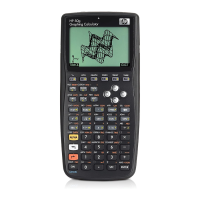Getting Started 15
Getting Started
15
44. Now press @³(EQW) to open the EquationWriter. This time, type ] F3 (C) Q 2 ENTER. appears on the stack
(see Figure 33). This is an Algebraic object. Press the UP cursor and you will see 'C^2' on the stack (see Figure 34). The
EquationWriter automatically surrounded the equation with ticks. In short, to prevent automatic execution of a variable, equation,
program or any other object, simply place it inside ticks. Press CANCEL to exit the interactive stack mode.
45. Now press ENTER to make a second copy of . Press @ followed by ENTER (->NUM) and the value of the variable C, 100,
is used, returning a result of 10000. (see Figure 35).
46. It can be tedious to type variable names every time. Since storing and using variables is essential for many complex calculations, a
quicker way is desired. Press VAR to show your variables again. This time, press
@ followed by the C menu key. Just as if you
typed 'C' and pressed RCL, the value is recalled. Type 2 then
/ and 50 appears. To save the value back into C, press !
followed by the C menu key. With
on Level 1, (you may have to press \ once) now press @ ENTER (->NUM) to evaluate
. Since 50 was used, the result this time is 2500. For more information on memory and memory management, see Chapter 26
of the HP 50g Graphing Calculator User’s Guide.
Closely related to the numerical solver we just explored is the HP Equation Library. The equation library contains hundreds of sorted equa-
tions organized into categories. These equations have detailed information about the equations, including pictures and variable informa-
tion. Using the equation library, you can numerically solve, with full unit support, series of related equations quickly by entering a few of
the variables. Also included with the 50g is the HP Periodic Table of the Elements. The Periodic Table of the Elements displays a graphical
version of The Periodic Table of the Elements and 23 different properties for each element, plots elements in relation to one another based
Figure 33 Figure 34 Figure 35

